Do you have that one place you can return to over and over again and never get tired of? For us, that’s Glacier National Park. After two trips and a lifetime of memories, it still feels like we haven’t even scratched the surface of this jawdropping place. Each visit was a completely different experience. One brought the worst weather we’ve ever experienced in a park while the other marked a very special moment for us, but both were trips we’ll never forget.
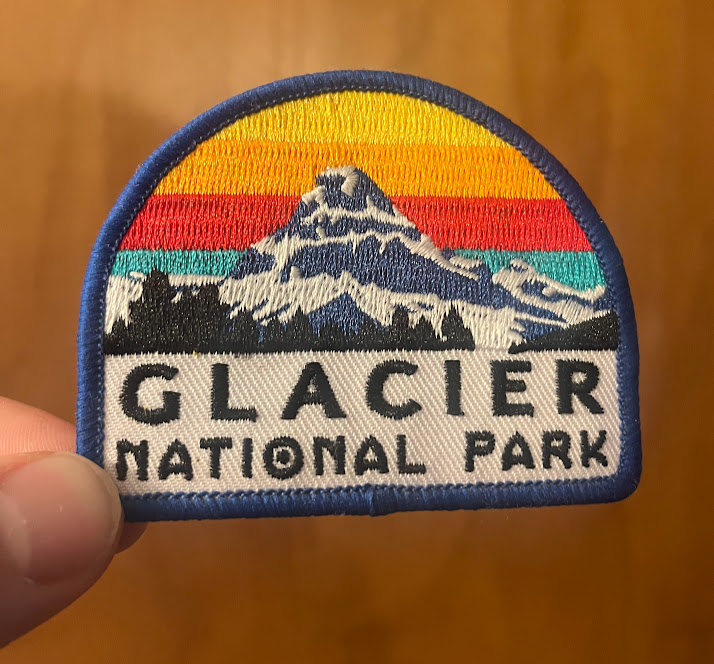
About the Park
Glacier National Park is in northwest Montana, along the Canadian border, where it connects with Waterton Lakes National Park in Alberta, Canada. The United States and Canada actually joined the two parks as the Waterton Glacier International Peace Park in 1932. The park is divided into East and West Glacier by the Continental Divide cutting directly through the park. Crossing the park on Going-to-the-Sun Road might just be the most scenic drive you’ll ever experience. Glacier is home to wildlife including mountain goats, bighorn sheep, bears, moose and even mountain lions. Also recognized as an International Dark Sky Park, Glacier is a great place to experience all the night sky has to offer.
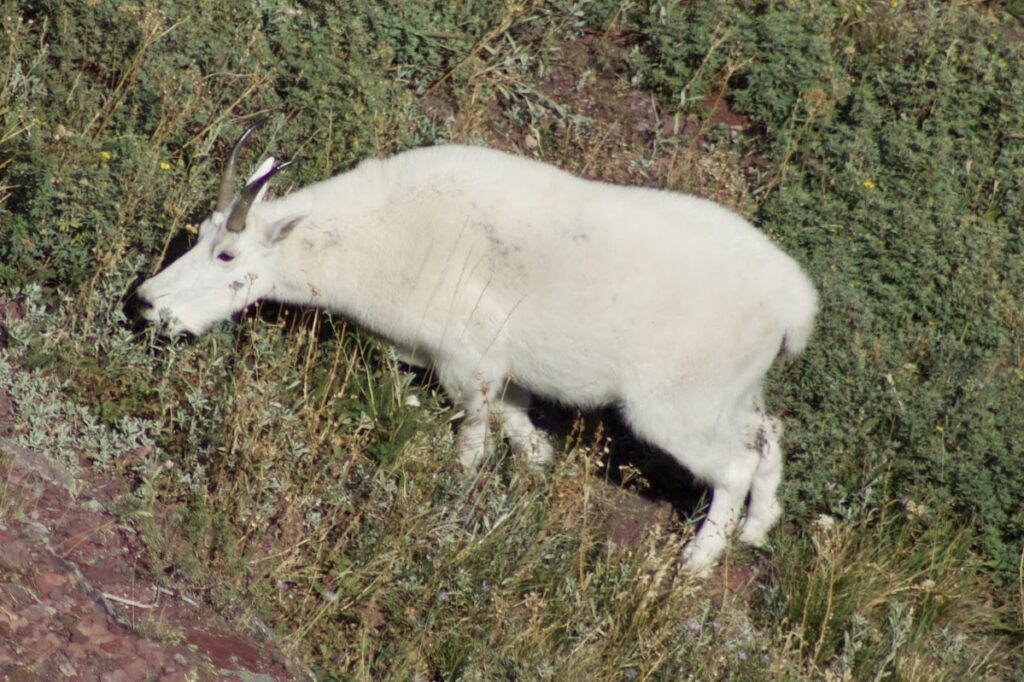
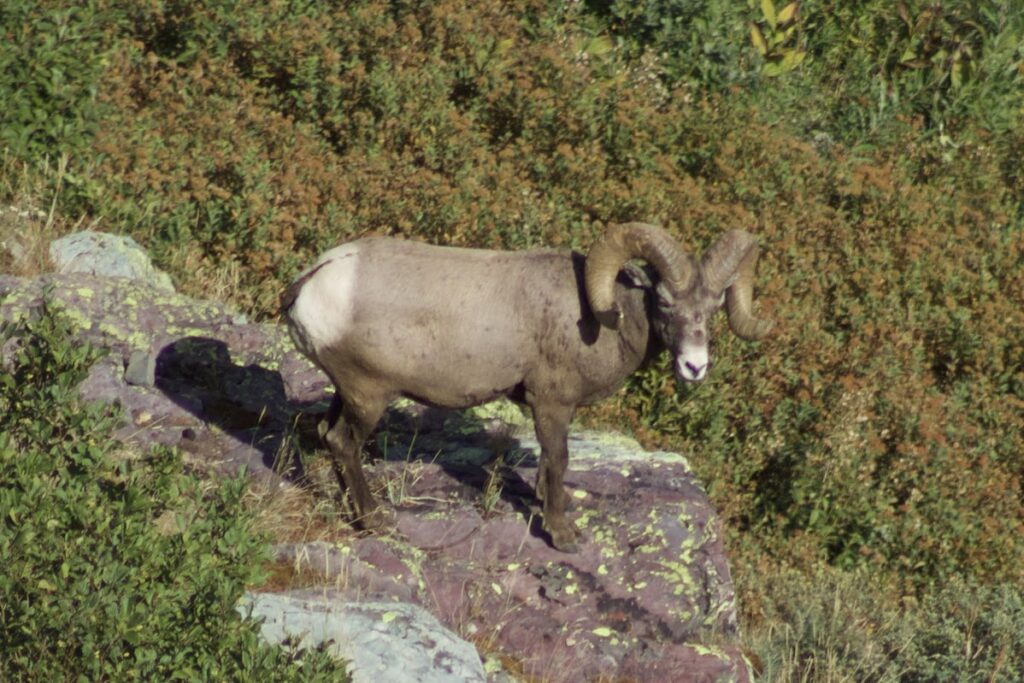
Need-to-Know Information
Areas of the Park
Glacier National Park can be separated into three distinct sections: West Glacier, East Glacier and Many Glacier.
West Glacier consists of the Apgar Village, the start of Going-to-the-Sun Road, Avalanche Lake and Lake McDonald.
East Glacier will give you the incredible mountain views you see in pictures. You’ll also have access to the Two Medicine area and Glacier Park Lodge.
Many Glacier is north of the east entrance to Going-to-the-Sun Road. Here you can find trails to Grinnell Glacier and Lake, Iceberg Lake and Ptarmigan Tunnel. The Many Glacier Hotel is also here on Swiftcurrent Lake.
Fees
For vehicles, the entrance fee is $35 and for motorcyles, it’s $30. For individuals without a vehicle, the fee is $20. The annual pass for access to only Glacier is $70 and the Interagency Pass is $80.
Vehicle Reservations
This part is extremely important. If you are planning a trip between June and the end of September, you’ll need a timed entry vehicle reservation to access Going-to-the-Sun Road between 7am and 3pm. Without a reservation, you’ll need to enter the park either before 7am or wait until after 3pm. Recreation.gov releases these reservations 120 days in advance, and you can purchase them online. If the date you want is sold out, don’t worry, you’ll get another shot when more go on sale the day before. Each vehicle only needs one pass.
If you are staying at one of the lodges or campgrounds within the park, you won’t need to get this reservation. You’ll just need to show the park rangers proof of your reservation.
We’ve never had any trouble getting a timed entry vehicle reservation for either of our trips to Glacier, but we’d still recommend trying to get it as early as possible.
Shuttle Service
We’ve never used this before but Glacier also offers a free shuttle service along Going-to-the-Sun Road from July through Labor Day.
The west side shuttle runs from Apgar Visitor Center to Logan Pass, while the east side shuttle runs from St. Mary Visitor Center to Logan Pass. Both shuttles run every day from 8am to 7pm.
If you’re looking to get to Logan Pass as quickly as possible, there is an express shuttle option that skips over all of the stops and goes straight there.
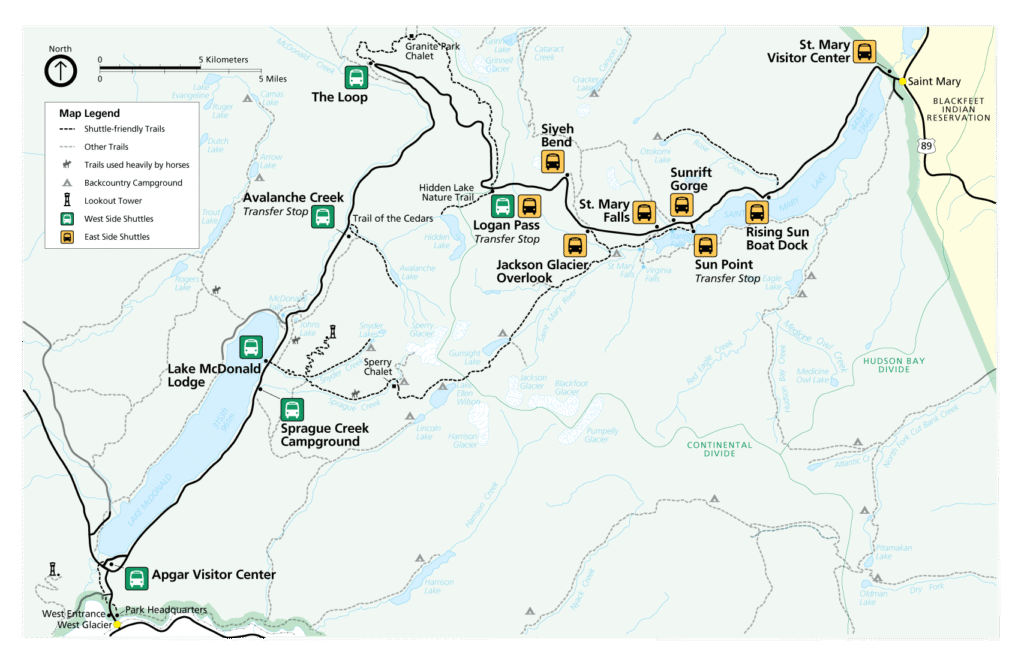
Airports/Rental Cars
Glacier Park International Airport (FCA)
Just south of the park, in Kalispell, MT, you’ll find the Glacier Park International Airport (FCA). Only about a 35 minute drive to the Apgar Visitor Center, this would be your best option if you want to fly directly to the area. It’s serviced by most of the major airlines such as Delta, United, American, Allegiant and Alaska Airlines and then also has flights from Sun Country and Avelo Airlines.
Our first trip to Glacier was part of a larger roadtrip with Boise ID, Grand Teton and Yellowstone so we only flew home from here. For our second trip, we flew directly in and out of this airport. It’s a small airport so getting through security was pretty quick for us both times.
For car rentals, you have a few options in the terminal and then a few others outside of the aiport.
In terminal rental options include Avis, Budget, Hertz and Alamo.
Options outside of the terminal include Dollar, Enterprise and Thrifty.
Missoula International Airport (MSO)
About three hours south of the West Glacier entrance, you’ll find the same airlines that fly into Glacier Park Airport, with the exception of Avelo Airlines. Frontier Airlines also operates flights here.
Car rental agencies in the airport include Alamo, Avis, Budget, Enterprise, Hertz, National and Thrifty. Outside of the airport, you have Dollar and Missoula Adventure Rentals.
Calgary International Airport (YYC)
Across the Canadian border, this one is three hours from East Glacier but about five hours from West Glacier. However, if you’re looking to combine your trip to Glacier with Canadian national parks such as Banff, Jasper and Waterton Lakes, this would be a great option. You will need your passport if you choose this airport.
Rental car options include Avis, Budget, Dollar, Thrifty, Enterprise, Hertz, National and Alamo.
Great Falls International Airport (GTF)
Southeast of the park, you’ll be about two and a half hours from the East Glacier entrance. Airlines here include Delta, United, Allegiant and Alaska Airlines.
Avis, Budget, Enterprise, Hertz, National and Alamo are your options for renting a car here.
Where to Stay
Whitefish, MT
Our personal favorite, Whitefish is about a 40 minute drive to the Apgar Visitor Center. Whitefish is a small mountain town that is popular year round. Winter time brings all the skiers and snowboarders while summer brings all the hikers and mountain bikers. There’s a walkable downtown that has restaurants, bars and plenty of shops to browse around in.
If you’re looking for things to do outside of the national park, there’s Whitefish Lake where you can water-ski, swim and fish. There’s also Whitefish Mountain where they have zip-lines, alpine slides, an aerial adventure park and a scenic lift ride to the peak. We chose to do the scenic lift on our first trip when the weather inside the park was less than ideal and from up top, you’ll have incredible views of Glacier National Park.
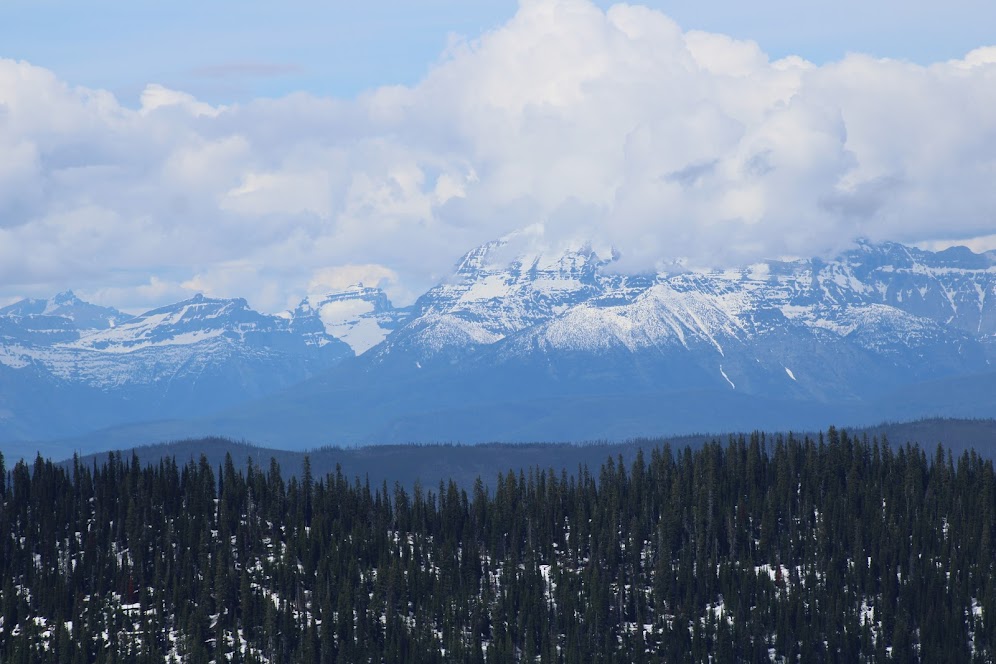
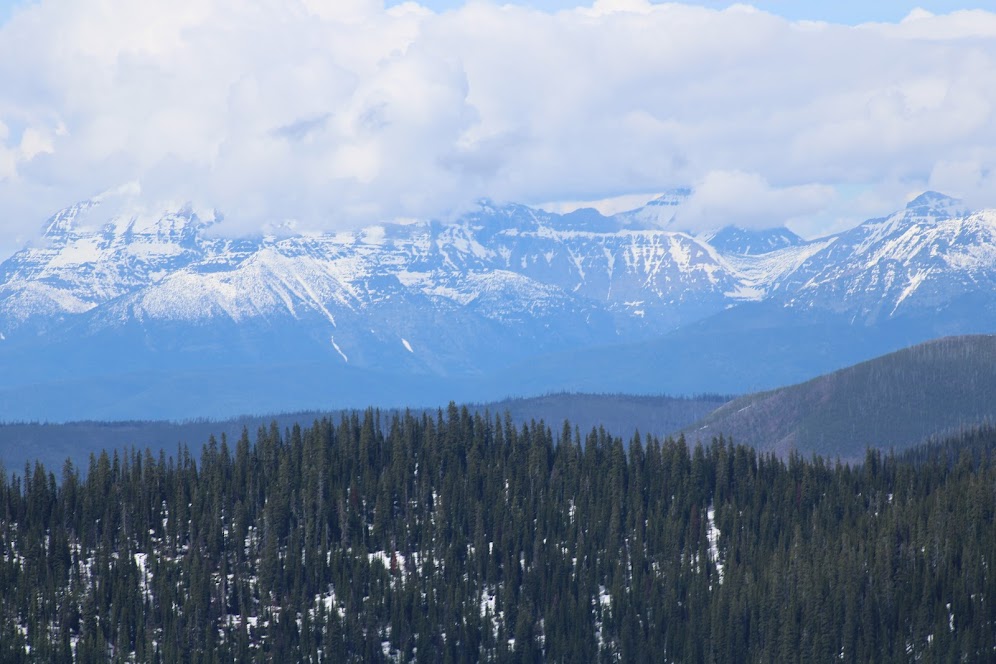
Columbia Falls, MT
Sitting between Whitefish and the west entrance to Glacier, Columbia Falls is in a very convenient location for getting to the park. Only 25 minutes away, you’ll be driving along Going-to-the-Sun road before you know it.
Other activities outside of the national park in Columbia Falls include whitewater rafting the Flathead River, a round of golf at the Meadow Lake Golf Course or spending some time at the waterpark.
We’ve stayed in both Whitefish and Columbia Falls and you really can’t go wrong with either option.
Kalispell, MT
Much larger than both Whitefish and Columbia Falls, Kalispell is very convienent if you’re flying in or out of Glacier Park International Airport. The drive to the west entrance is only slightly longer when compared to the drive from Whitefish. Main Street has restaurants and shops and staying here will most likely be your most affordable option of the three.
Park Lodging
If you’re looking to stay in the park, there are a lot of options to choose from.
On the West Glacier side, you have the Lake McDonald Lodge, Apgar Village Lodge and Motel Lake McDonald. There is also a backcountry chalet that you can hike to called the Sperry Chalet.
East Glacier gives you the Rising Sun Motor Inn and the Glacier Park Lodge.
Up in the Many Glacier area, you’ll find the Swiftcurrent Motor Inn and the Many Glacier Hotel.
All of these can be seen on the above map. We highly recommend trying to book these way in advance as park lodging usually books up pretty fast.
Going-to-the-Sun Road
When you think bucket list, this road deserves to be on every single one. Arguably the most scenic drive in the United States, Going-to-the-Sun Road is one that lives up to all of the hype. However, if you want to have the opportunity to drive the entire road and completely take it all in, it’s extremely important to stay up to date with the status of the seasonal road closure. We learned our lesson about this the hard way during our first visit.
Every spring, the park’s snowplows need to clear the road from all that winter season’s snowfall. Typically, the road doesn’t fully open until early to mid July so if you’re planning to visit before that, be sure to check the park’s website for the current status. The National Park Service maintains a historical record of when Logan Pass opened, although it looks like 2023 and 2024 haven’t been updated yet. The good news is that despite all this, you’re still able to enjoy the portion of the road that’s been fully cleared. You’ll be able to walk or bike up to the end of the cleared section.
Unfortunately for us, we weren’t aware of this our first time as we were there in mid-June of 2022. The road was only open up to the Loop (see shuttle service map above), so we could only see a small portion of it. On top of that, we learned firsthand what an atmospheric river is, meaning even for the part that was open, it was not exactly the most enjoyable experience. For our entire walk along the road, the mountains and forests were covered in clouds, the rain never stopped and the McDonald Creek, which runs alongside the road, was almost overflowing onto the road. Luckily we bought ponchos at one of the gift shops though!
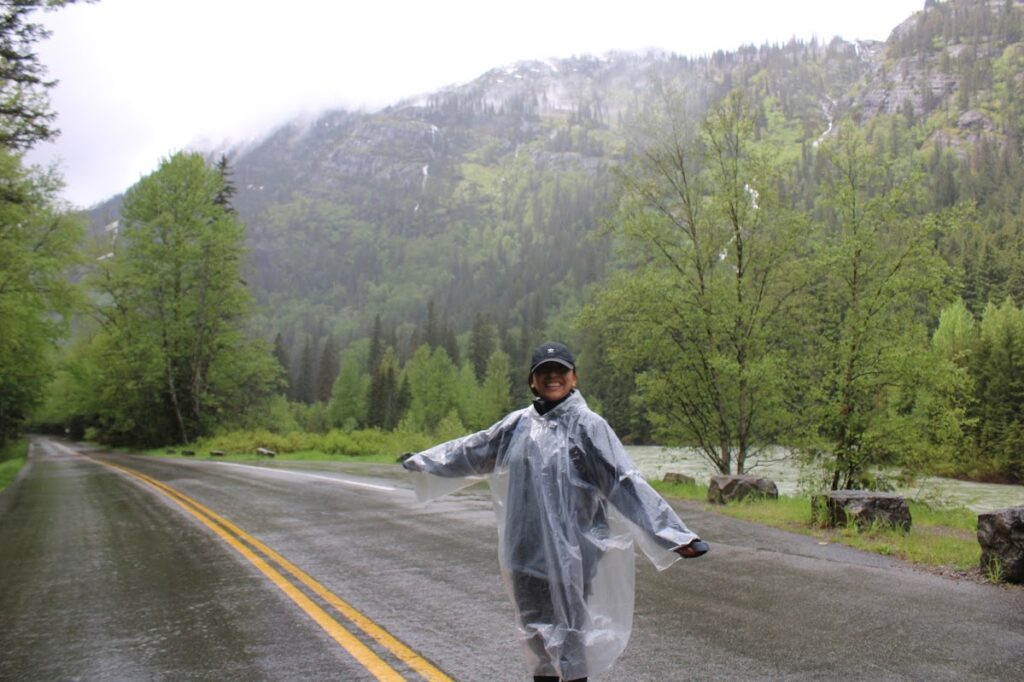

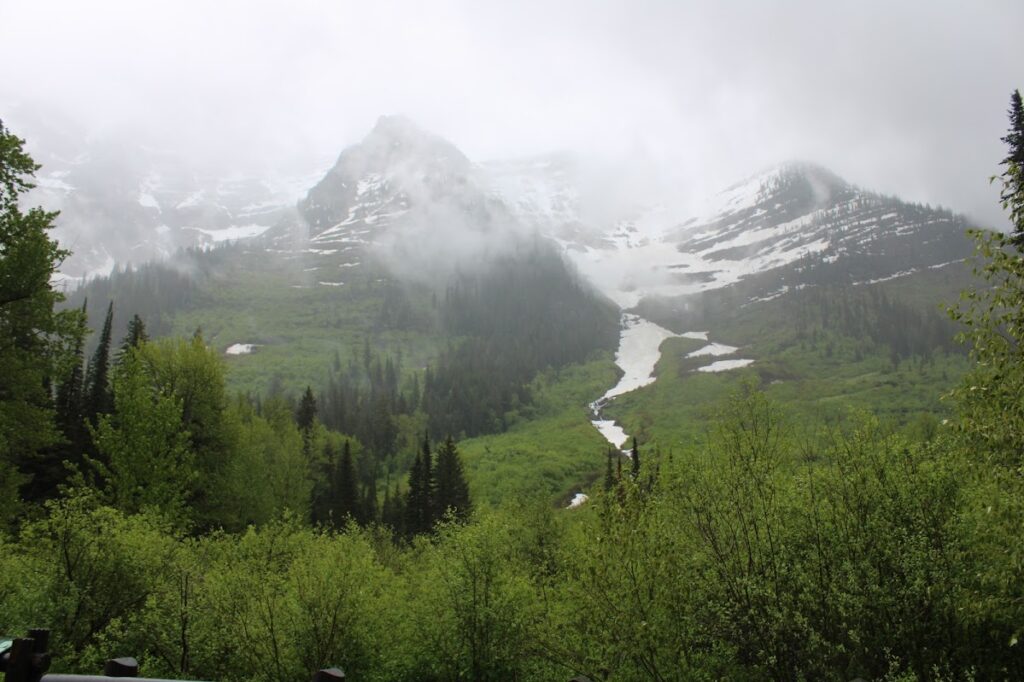

This experience wasn’t exactly what we were expecting but it only made us want to come back to the park as soon as possible.
Two years later in, August 2024, we went back, and this time, we saw some of the most breathtaking views from a road we had only dreamed of. We also saw a wedding at one of the rest stops!
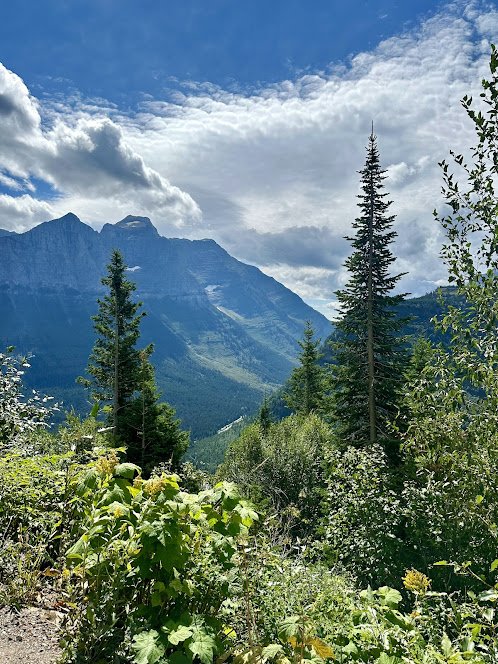
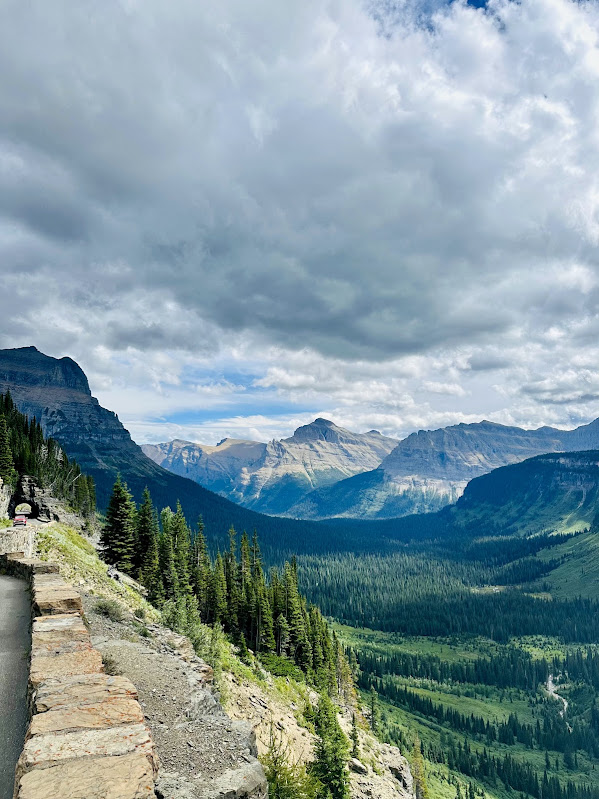
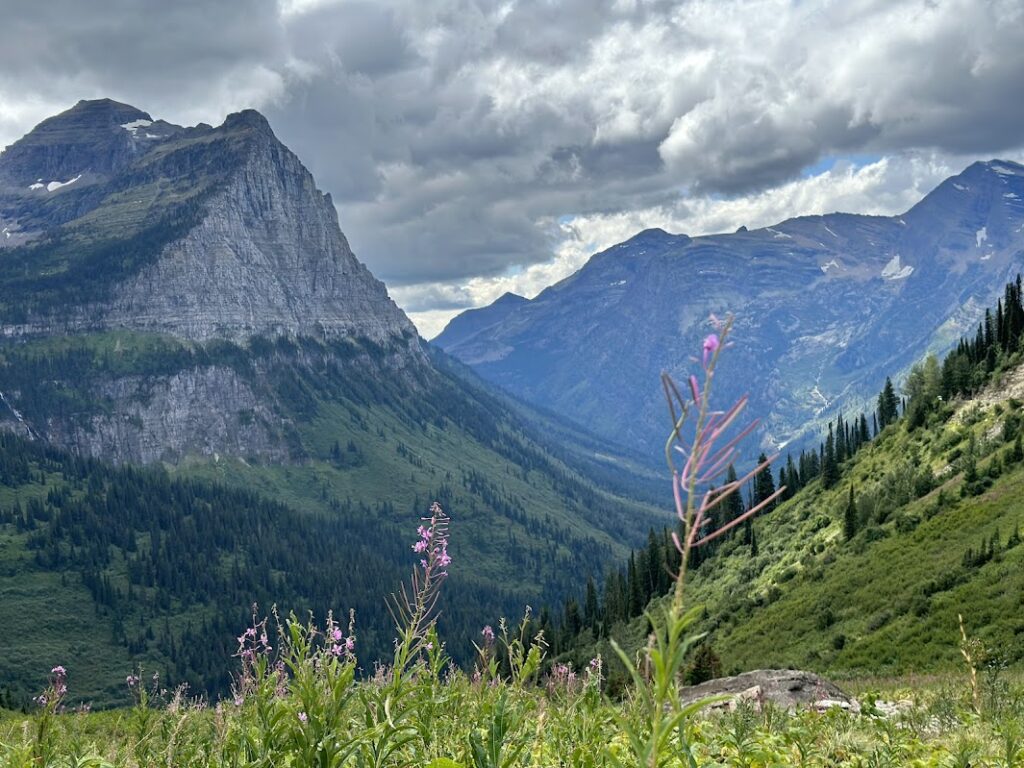
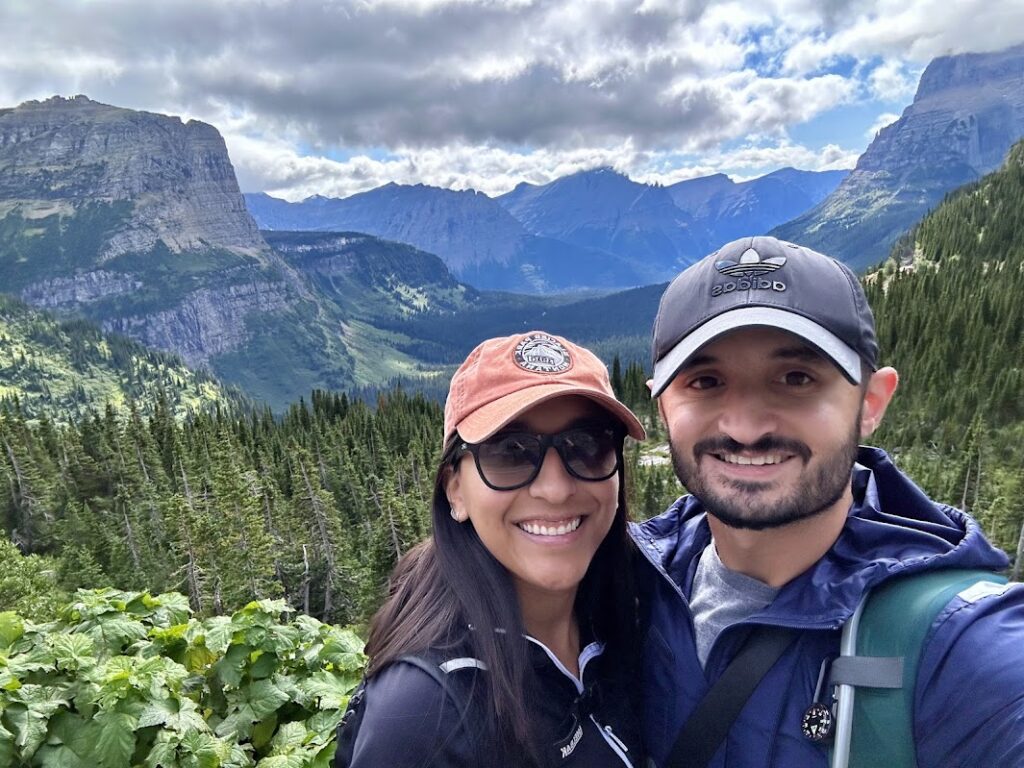
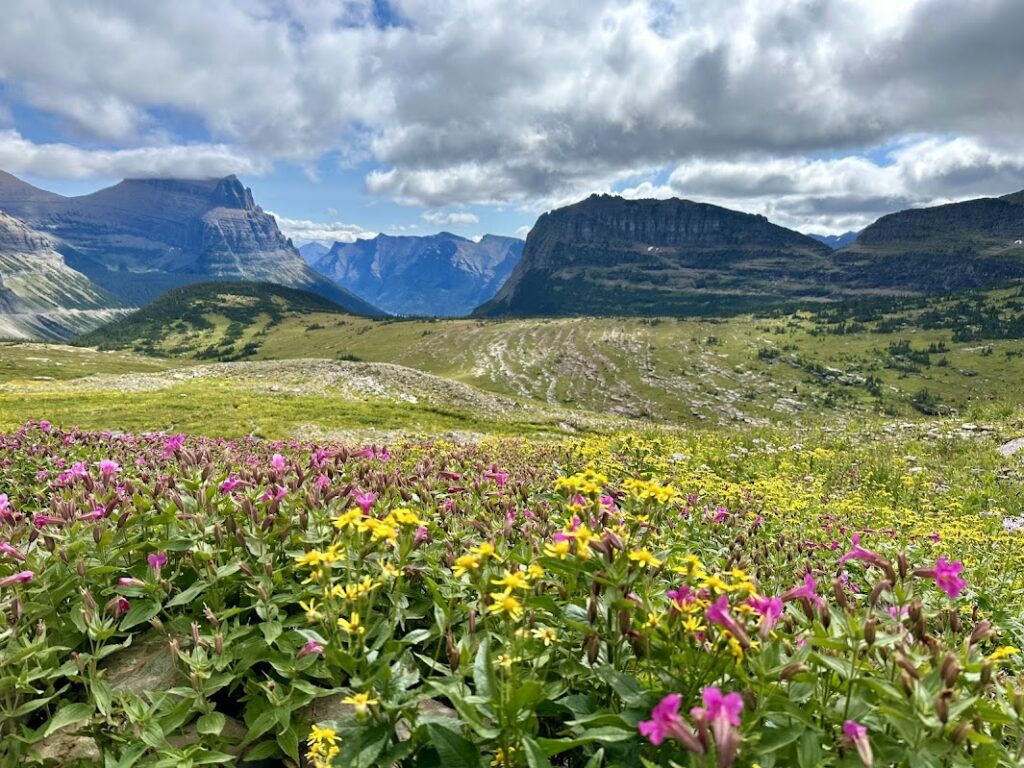
If you only spend one day in Glacier, driving Going-to-the-Sun road the entire distance is the one thing you should absolutely do.
West Glacier
Avalanche Lake Trail
Perhaps the most popular trail on the west side of the park, this one is extra special to us. At 6 miles round trip, this isn’t too challenging of a hike. With not much elevation gain, this is an out & back hike that will take a few hours to complete, depending on how long you end up enjoying the lake. This is also a very popular trail so expect there to be a lot of other people.
Parking can be tricky depending on the time of day and time of year. There is a small parking lot at the campground that usually fills up first. Across the street on Going-to-the-Sun Road, there is another lot that fits more cars. If you’re there in the summer when the road is fully open to cars, there is a third lot not too far down the road near the Trail of the Cedars Trailhead. Hopefully, you’ll be able to find a spot at one of these. We have had to spend some time driving around waiting for one to open up, which eventually will happen.
This trail is a tale of two stories for us as both times were memorable in their own way.
On our first trip, we had to deal with the rain from the previously mentioned atmospheric river that was hitting the park that June. Avalanche Creek was absolutely roaring and eventually, the rangers had to close the trail as the trail was overflowing, causing dangerous conditions.
By the end of the trail, there wasn’t much to see as clouds covered much of the lake, although, they did clear slightly for a short amount of time.

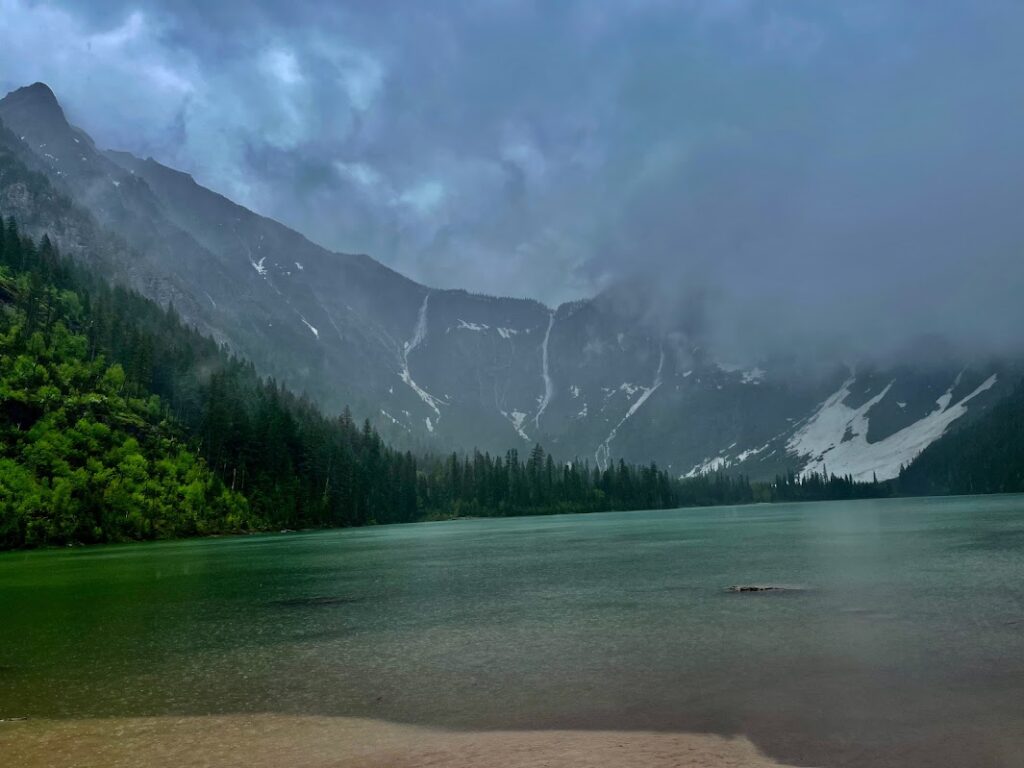
We had much better luck during our second trip in August 2024, making this a trail one we’ll never forget.
To start, we were lucky enough to see a mama bear and her cubs playing along the trail and then eventually run off into the forest. Unfortunately, they moved too quickly so we weren’t able to get any pictures but we were able to enjoy the moment.
Once that was over, we continued to the end of the trail at the lake. Little did Anna know, I had other motives for returning to Avalanche Lake. My brother and sister-in-law started the hike around 6:30am to make sure they were there before us. When we got to the lake, Anna was busy taking pictures so I ran ahead to try and find them. Once I did, they hid in the trees and waited for Anna to catch up. Then it was time to pop the question! She said Yes!
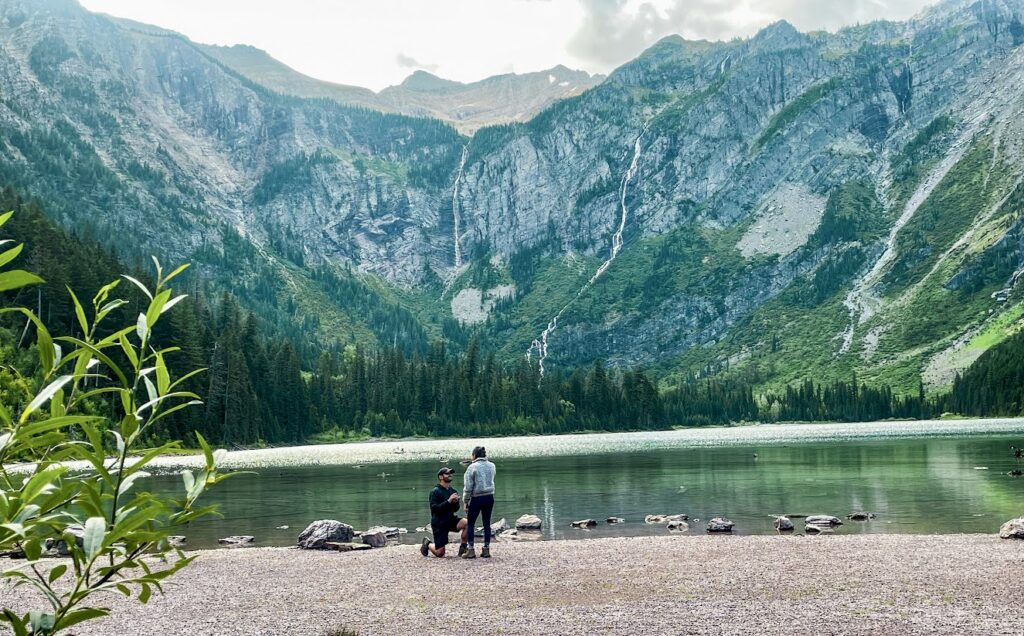
Avalanche Lake is an incredible hike and the view at the end is simply stunning.
Avalanche Lake can also be combined with the Trail of the Cedars. You’ll be walking among the cedars and hemlocks of Glacier on this mile long, boardwalk trail that is accessible to everyone.
Lake McDonald
Lake McDonald is the parks largest and deepest lake, stretching ten miles alongside Going-to-the-Sun Road. Swimming, kayaking and fishing are among the activities you can get involved with on the lake. If you’re looking for a more laid back experience, there are also scenic boat tours that leave from Apgar Village run by Glacier Park Boat Co. If you’ve seen those photos of Glacier with the colorful rocks on social media, there’s a strong likelihood those were taken at Lake McDonald.
Sperry Chalet
From Lake McDonald, the Sperry Chalet trail takes you to one of two backcountry lodging options in the park. The trail is 6.3 miles long with about 3,400 feet of elevation gain. You’ll be overlooking Lake McDonald.
East Glacier
If you’re driving from west to east, East Glacier includes everything on Going-to-the-Sun Road beyond the Loop. Another popular destination on the east side is the Two Medicine Lake area.
Two of the most popular trails are accessible from the Logan Pass Visitor Center along Going-to-the-Sun Road. These are the Hidden Lake Overlook and the Highline Trail.
Hidden Lake Overlook
Not too challenging, the Hidden Lake Overlook trail is short and you may even see mountain goats or bighorn sheep. You’ll follow the boardwalk for the majority of the trail until you reach the overlook. When we were there, it was very windy conditions so we didn’t stay long. You can also go beyond the overlook and continue on the trail down to the lake. This would add an additional 1.2 miles each way.
For a quick hike, definitely consider this one.
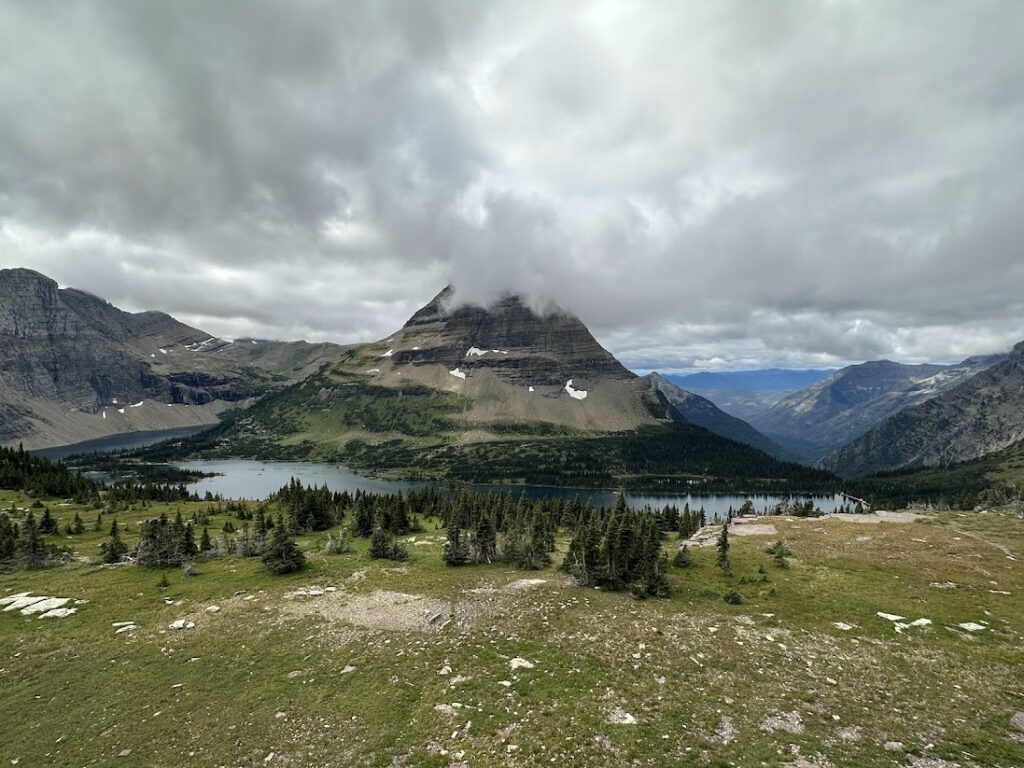
Highline Trail
For a much longer and more challenging hike, the Highline Trail is what you’d be looking for. This trail can be hiked in a few different ways.
The most popular option is to hike out-and-back to the Granite Park Chalet. This is the other backcountry lodging option Glacier offers. Fifteen miles long with over 2,600 feet of elevation gain, this trail runs alongside Going-to-the-Sun Road most of the way.
A second option would be to hike to the Loop trailhead by taking the Highline Trail to the Granite Park Trail. This will be about twelve miles one way. This would be a good option if you’re utlizing the shuttle service and don’t need to worry about getting back to a car.
A third option would be to take this trail to the Garden Wall Trail. This will take you to an overlook of Grinnell Glacier. If you are short on time and won’t be able to make it over to the Many Glacier area on your trip, this would be a good way to see both the Highline Trail and Grinnell Glacier. Otherwise, we’d recommend actually hiking to the glacier, which we’ll talk about shortly.
Two Medicine Lake
We made the drive over to the Two Medicine area during our trip in 2022. With the bad weather in West Glacier, a ranger mentioned that East Glacier was mostly clear. Since Going-to-the-Sun Road was closed, we had to take the long way around via Route 2. This took almost two hours but it’s a nice, scenic drive.
Once there, you have some options on things you can do. Let’s start with hiking.
The Upper Two Medicine Trail takes you past Two Medicine Lake to Upper Two Medicine Lake. It’s a long trail at just over nine miles but there’s not too much elevation gain.
We were planning on hiking this, but when we started, parts of the trail were under knee-high water. We decided we didn’t want to deal with that so we turned back.
Similar to Lake McDonald, Glacier Park Boat Co. also offers a boat tour on the lake. We ended up doing this instead of hiking and it cost about $40 total for the two of us. The tour lasts about 45 minutes to an hour, and you’ll have the opportunity to learn all about the tribal history in that area. You’ll get up close to Sinopah Mountain and Rising Wolf Mountain.
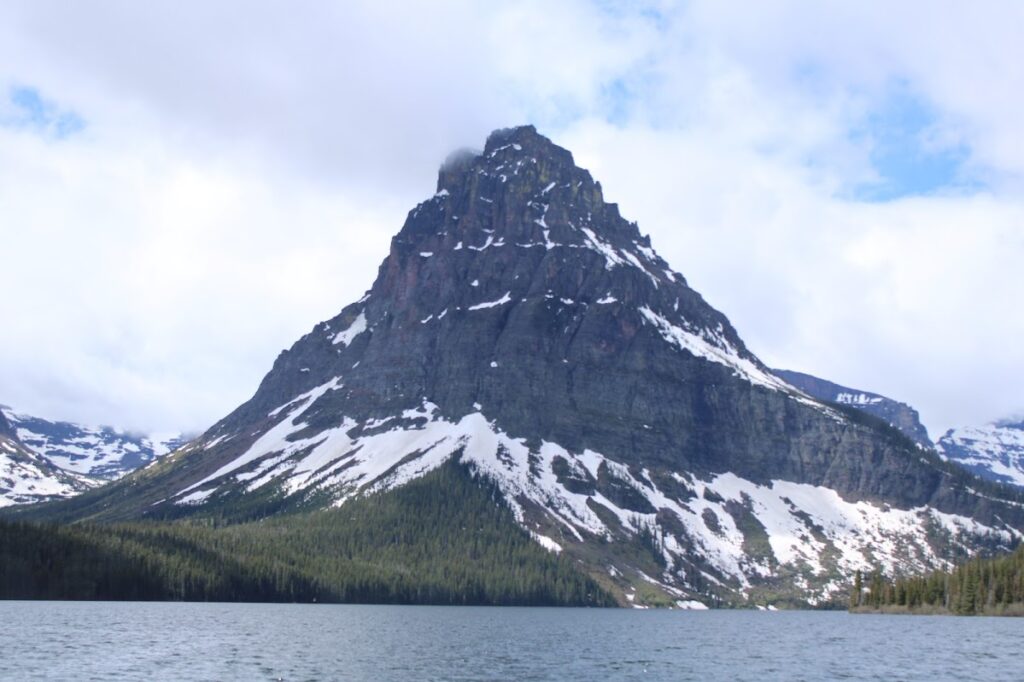
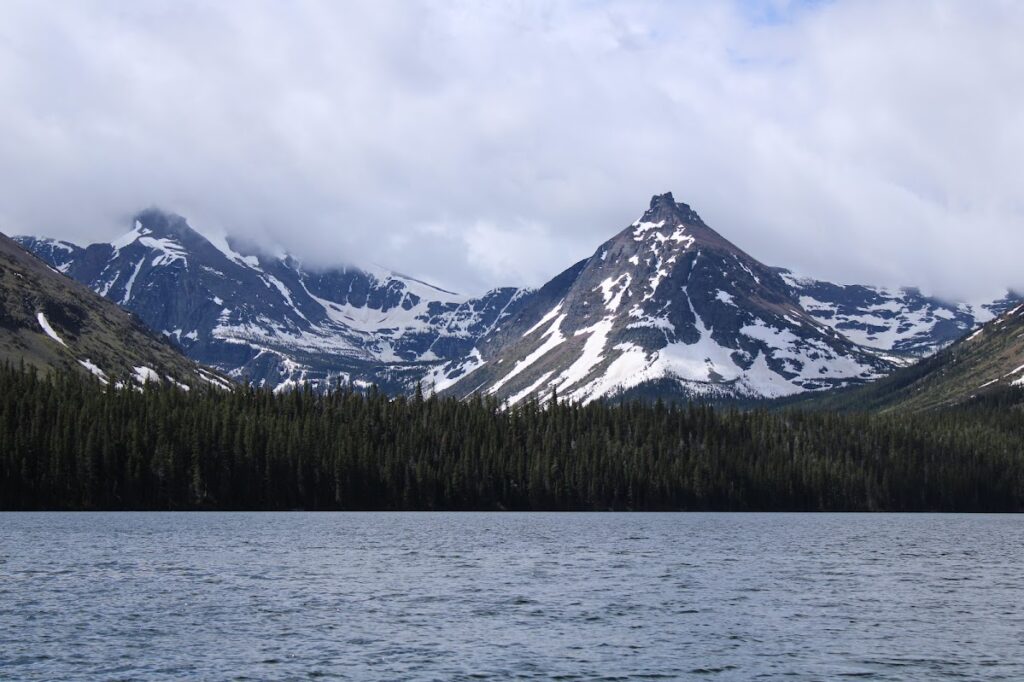
Also, for reference on how quickly the weather could change, the two pictures below were taken five minutes apart from each other. About ten minutes later, the storm passed and the sky cleared up again. Make sure to always follow the weather forecast and know if there is any possibility of a storm passing through. Even checking with the park rangers can save you from being stuck in uncomfortable situations.
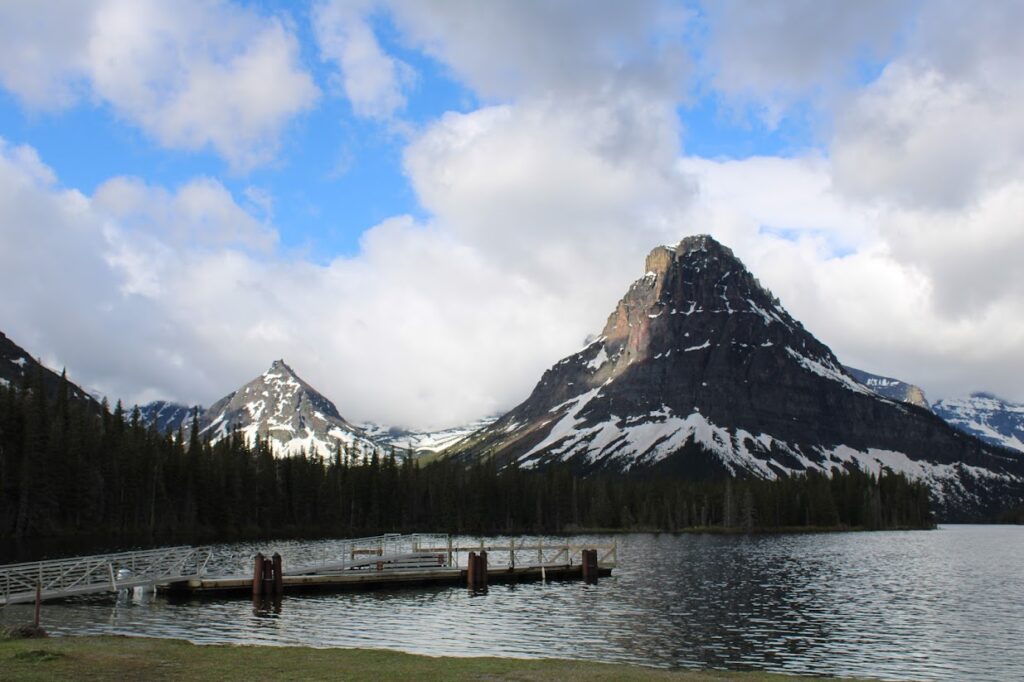

Many Glacier
North of Going-to-the-Sun Road, Many Glacier might be a little harder to reach, but is worth every effort. Hikes to Grinnell Glacier, Iceberg Lake and the Ptarmigan Tunnel are the highlights on this portion of the park.
Grinnell Glacier
As previously mentioned, you have the option of going to the Grinnell Glacier Overlook from the Highline Trail. If you have enough time, we think you should make it a priority to spend some time at Many Glacier and hike the Grinnell Glacier Trail. The best part is that it’s basically a two-for-one. Not only do you end the trail at the glacier, but after you pass Lake Josephine, you have an absolutely beautiful view of Grinnell Lake. The turquoise waters are something you have to see for yourself.
The trail is ten miles long but there is an option to shorten it. If you don’t want to hike the entire way, you can combine the hike with the Many Glacier boat tour from Glacier Park Boat Co. The tour will start by taking you across Swiftcurrent Lake. Once at the end, you’ll get off that boat and hike over to Lake Josephine where you’ll get on another boat to cross that lake. This would be a nice way to shorten your hike while also learning about the area and seeing it from a different perspective.
Tickets were sold out when we tried to purchase so we ended up hiking the full trail. The beginning part of the trail by Swiftcurrent Lake and Lake Josephine wasn’t too challenging as it’s mostly flat. We even were lucky enough to see a black bear swimming across Lake Josephine.
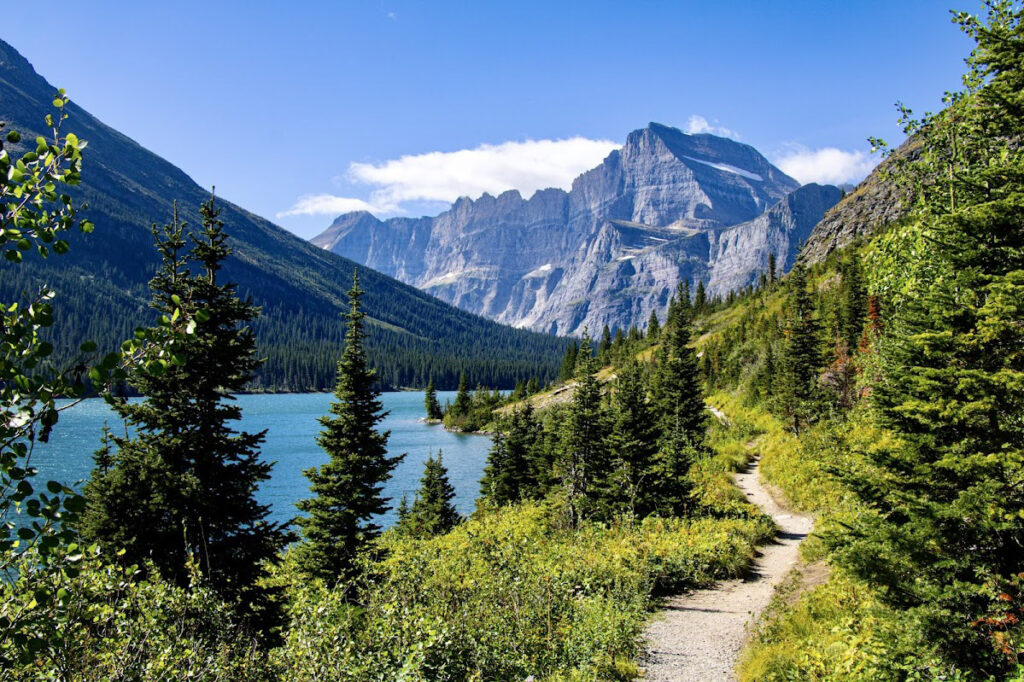
After passing Lake Josephine, the hike gets much more challenging as the rest of trail from here is going up. Once you get that first glimpse of Grinnell Lake, however, you’ll just want to keep going.
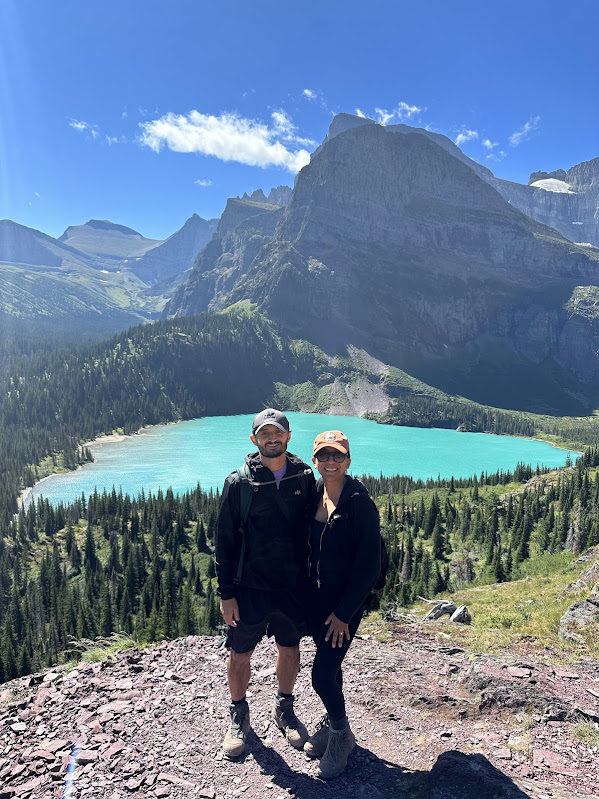
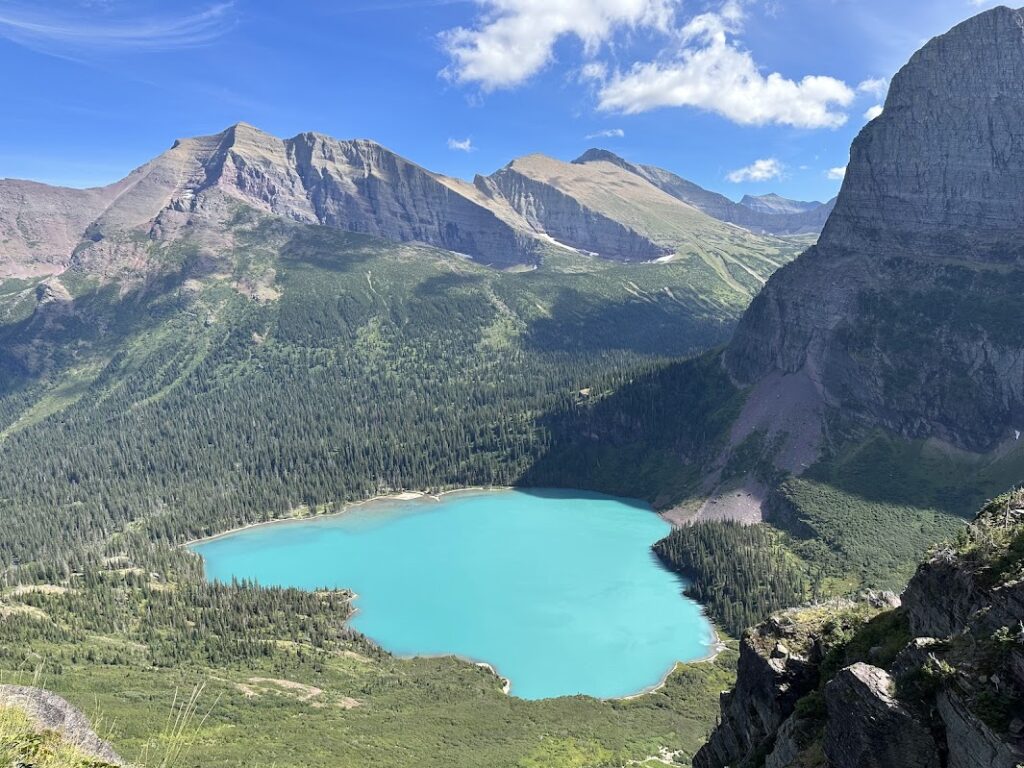
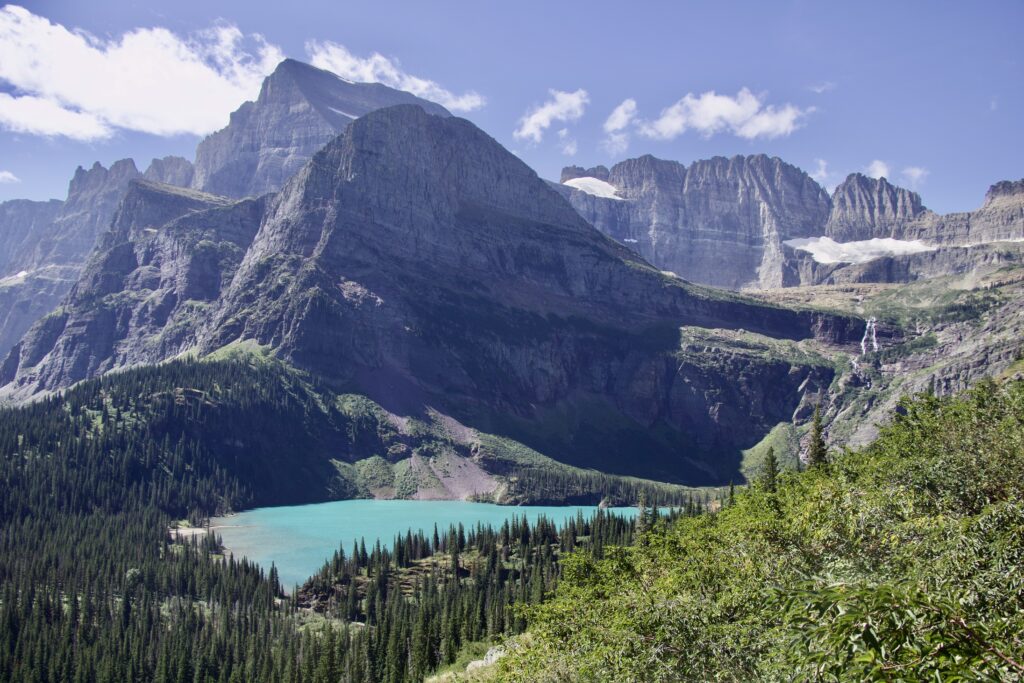
After passing Grinnell Lake, the rest of the trail leads to Grinnell Glacier. Between the lake and glacier, we lost count of how many big horn sheep we saw. There were even a couple of mountain goats.
Honestly, as impressive as the glacier was, it almost seemed disappointing after staring at the lake the entire way up.


The glacier was a great place to take a break and eat some lunch before heading back down. If you think the views were done, there’s still one more. Heading down from the glacier, you’ll have a view of all three lakes: Grinnell, Josephine and Swiftcurrent.
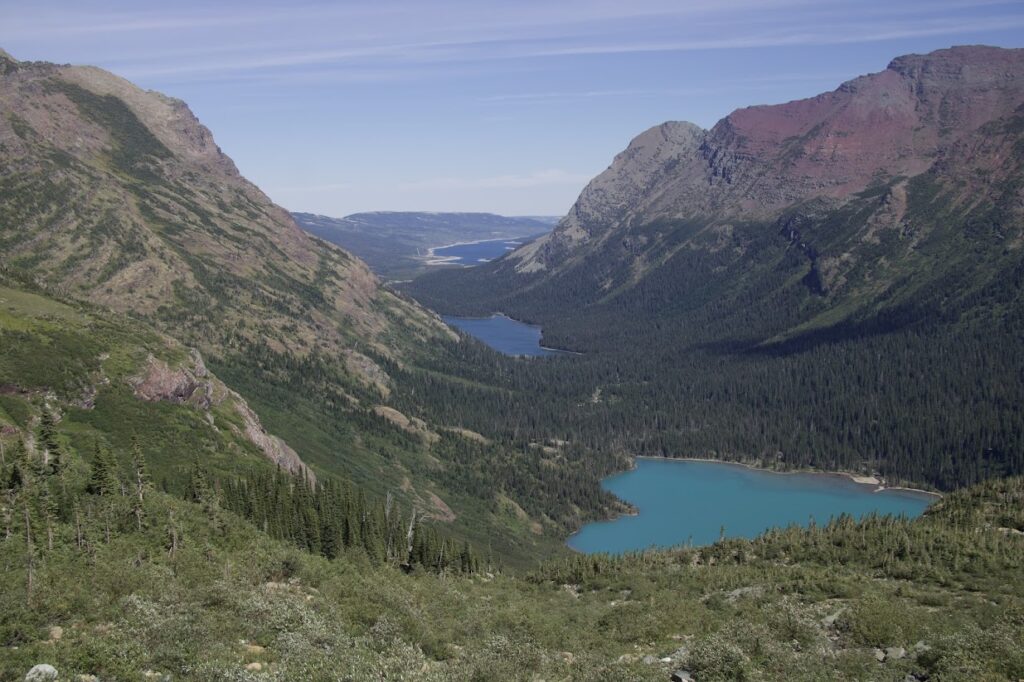
This is one of our absolute favorite hikes and we think you should make every effort to experience it for yourself.
Iceberg Lake
We didn’t have time to hike this one ourselves, but Iceberg Lake is one of the most popular trails in the Many Glacier area. Just under ten miles roundtrip, it leads to a stunning alpine lake. It’s high on our list for our next visit!
Ptarmigan Tunnel
Along the Iceberg Lake Trail, you’ll come to a junction. One path continues on to Iceberg Lake, while the other branches off onto the Ptarmigan Trail. This route takes you to the Ptarmigan Tunnel, a historic tunnel carved through the mountain in the 1930s by the Civilian Conservation Corps (CCC). If you’re a fan of history, this trail will give you a memorable experience. Like the Iceberg Trail, this is one we didn’t have time for but would definitely hike the next time we make it to Glacier.
Closing Thoughts
Drive Going-to-the-Sun Road. Hike to Avalanche Lake, Iceberg Lake, Grinnell Lake, Grinnell Glacier, and the Highline Trail. Spend three to four days in this park and you won’t regret it. It’s mindblowing how spectacular this place truly is. You’ll find yourself thinking about it at random times months after you went. It’s currently our favorite park and honestly, it’s going to be pretty hard to beat.
